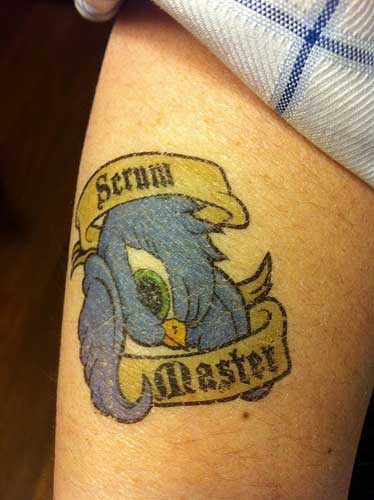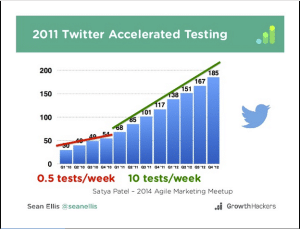
What are the duties of a Scrum Master? How do you choose someone who will make a successful scrum master, what personality traits and skills do you look for? And are there differences between the role, duties and skillset necessary to become a successful scrum master for Agile Marketing, as compared to Agile Development? I’ve been asking myself these questions lately, and I’d like to share my thoughts and ask you to share yours.
The Duties of the Scrum Master
The Scrum Master’s job, whether on an Agile Development or an Agile Marketing team, is to make the team successful. The scrum master is not the “boss” or the manager of the team. His (or her) job is to remove obstacles, so that the team can accomplish the tasks they’ve assigned themselves in the Sprint.
The Scrum Master schedules and runs the daily standup. They track obstacles, and resolve obstacles after or outside the daily standup meeting itself. The Scrum Master maintains the marketing backlog, and organizes and runs the Sprint planning sessions, the Sprint review and the Sprint retrospective. The Scrum Master also enforces Scrum discipline – in other words, making sure that the processes and ceremonies of Scrum are followed to the extent that the team has decided to follow them. The Scrum Master makse sure that user stories are written in appropriate formats, for example.
Some teams practice what is known as “Scrumbut”, as in “we practice Scrum, but we don’t do X, Y and Z”. This is fine if the team consciously decides not to follow some of the practices of Scrum, but this should be a conscious decision, not, as is common, an unconscious decision as a result of a lack of discipline. The Scrum Master is the conscience of Scrum.
 The Scrum Master also tracks the Sprint. He gathers information at each daily standup about the progress made, and the work remaining to be done. He may track the work remaining in a burndown chart. The burndown chart compares the idealized progress of the team towards finishing the work of the Sprint to the actual progress. This allows the team to see where they are, and the work necessary to finish on time.
The Scrum Master also tracks the Sprint. He gathers information at each daily standup about the progress made, and the work remaining to be done. He may track the work remaining in a burndown chart. The burndown chart compares the idealized progress of the team towards finishing the work of the Sprint to the actual progress. This allows the team to see where they are, and the work necessary to finish on time.
How to Choose a Successful Scrum Master
On small teams (5 people or less), depending on the personality and the skill set of the marketing leader, the leader may also serve as the Scrum Master. In order for this to succeed, the marketing leader must be organized and detail-oriented, and more importantly, they must be someone that the team trusts to serve their best interests. An authoritarian leader, who rules by fear and discipline, will not succeed in this role.
For larger teams, or ones where the marketing leader does not have the requisite personality or skill set, someone on the team must be chosen as Scrum Master. In addition to possessing the organization and attention to detail characteristic of any good project manager, the ideal Scrum Master is both servant and driver. The person must serve the team, removing obstacles to help the team get their work done. They put the team’s needs above their own needs, and are trusted by both the team and management. At the same time, they must watch for complacency, and drive the team to complete work on time and with good quality.
The Scrum Master must also be someone with good communication, political and negotiation skills. They must communicate not only to the team, but also to management and other areas of the organization, in order to both promote and protect the team. They must be politically savvy in order to be effective in removing obstacles caused by the competing priorities of different parts of the organization. And they must have great negotiation skills, again not only to negotiate with the team deadlines and commitments, but also to negotiate outside the team, to avoid over committing the team and preventing unnecessary change during the Sprint.
In both my experience and talking to Agile Developers, traditional project managers often don’t make good Scrum Masters. They tend to focus overly on the tracking and control aspects of project management, and not enough on the removing obstacles duties of the Scrum Master. There are exceptions, of course.
Agile Development vs Agile Marketing Scrum Master
Are there differences between someone who makes a good Scrum Master for agile development vs someone who makes a good Scrum Master for Agile Marketing? I think there are slight differences, but I don’t think they’re huge. On Agile Development teams, the role of Scrum Master is often a full-time position, or at least a near full-time position. In my experience, most marketing Scrum Masters take this on in addition to their regular duties. Second, I find that most marketing teams are less formal in their practice of Scrum, having standup meetings 2-3 times a week rather than daily, not doing sophisticated estimates, and not tracking the work formally in a burndown chart. From this perspective, at least, there is less for an Agile Marketing Scrum Master to do.
The greatest value of a Scrum Master, however, is the ability to track and eliminate obstacles for the team, and in my experience, the Agile Marketing Scrum Master must be a master at this function. Not everyone can write code, and at least part of the time, management will defer to the technical judgment of the development team. It’s more common for everyone to think that they can do marketing, and there seems to be more opportunity for interference in the job of marketing. Marketing today also lives in a real-time world, and someone has to decide whether a new, real-time demand is something that is worthwhile interrupting the flow of the marketing team for, or to push back, and ask that it be scheduled at a future sprint. It is usually the Scrum Master who fights these battles.
The Agile Marketing Scrum Master must be particularly strong in communication, negotiation and political savvy. They must be very well respected both by the team and by management so that they can effectively perform the task of eliminating obstacles.
What is your experience? If you’re practicing Agile Marketing, do you have someone in the role of Scrum Master? What do you think is required for a successful Agile Marketing scrum master?



Great post Jim, I think it would be helpful to interview some scrum masters, get their perspective, and also ask a team that hasn’t had someone in this separate role give their perspective on the differences with one and without.
As a (somewhat) traditional project manager who has served as a Scrum Master on an agile development team, I’ve found that Ticket Driven Development (TiDD) with automated workflows makes it easier for me to address issues before they might become obstacles i.e. if there’s no ticket, there’s no work, and an automated workflow that assigns the new ticket to the Scrum Master gives him time to analyze the issue before deciding on a course of action.
I think this practice would work well on an agile marketing team, as well. Interference can be avoided by creating a single point of contact (the Scrum Master) for all inquiries, ideas and requests.
https://blogs.atlassian.com/2013/03/what-is-ticket-driven-development-and-why-is-it-attracting-attention-in-japan/
Joel,
Thanks for the comment. I’ve not heard about ticket-driven development, but it makes sense. It adds another level of discipline and workflow to the practice.
-Jim
Pingback: Digital demand and supply: the psychology of self-development for digital careers
Pingback: agile scrum master books – innasart